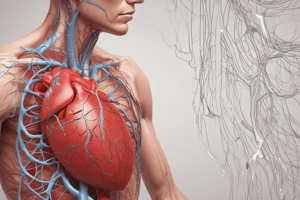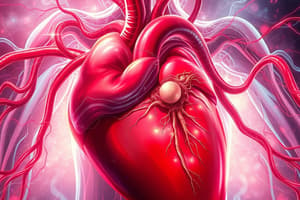Podcast
Questions and Answers
What is the main function of the circulatory system?
What is the main function of the circulatory system?
- Transporting oxygen and nutrients (correct)
- Filtering waste
- Producing hormones
- Generating energy
What is the name of the pressure exerted by blood against vessel walls?
What is the name of the pressure exerted by blood against vessel walls?
- Osmotic pressure
- Atmospheric pressure
- Hydrostatic pressure
- Blood pressure (correct)
Which type of blood flow is smooth and follows parallel layers?
Which type of blood flow is smooth and follows parallel layers?
- Chaotic
- Turbulent
- Laminar (correct)
- Pulsatile
Which unit is used to measure blood pressure?
Which unit is used to measure blood pressure?
What is a key characteristic of laminar blood flow in large arteries?
What is a key characteristic of laminar blood flow in large arteries?
What is the normal resting heart rate for an adult?
What is the normal resting heart rate for an adult?
Which physical property of the arterial wall primarily influences the propagation speed of the blood pressure wave?
Which physical property of the arterial wall primarily influences the propagation speed of the blood pressure wave?
Which of the following is true about turbulent blood flow?
Which of the following is true about turbulent blood flow?
The second law of thermodynamics is a fundamental law of thermodynamics, stating that in a thermodynamically _____ system there exists a state function that does not decrease over time:
The second law of thermodynamics is a fundamental law of thermodynamics, stating that in a thermodynamically _____ system there exists a state function that does not decrease over time:
Zero on the Kelvin scale means the lowest theoretically possible temperature that a body can have. This is the temperature at which (according to classical physics) all vibrations of molecules cease (absolute zero):
Zero on the Kelvin scale means the lowest theoretically possible temperature that a body can have. This is the temperature at which (according to classical physics) all vibrations of molecules cease (absolute zero):
Entropy (S) - Mark the false sentence:
Entropy (S) - Mark the false sentence:
Evaporation is change:
Evaporation is change:
Which law of thermodynamics states that the total energy in a closed system remains constant?
Which law of thermodynamics states that the total energy in a closed system remains constant?
According to the second law of thermodynamics, what happens to entropy in an isolated system over time?
According to the second law of thermodynamics, what happens to entropy in an isolated system over time?
Which mechanism of heat transfer occurs through direct contact between molecules?
Which mechanism of heat transfer occurs through direct contact between molecules?
Which of the following is true about turbulent blood flow?
Which of the following is true about turbulent blood flow?
Flashcards
Circulatory System Function
Circulatory System Function
The circulatory system transports oxygen and nutrients throughout the body.
Blood Pressure
Blood Pressure
Blood pressure is the force exerted by blood against the walls of blood vessels.
Laminar Blood Flow
Laminar Blood Flow
Laminar blood flow is smooth and orderly, with blood moving in parallel layers.
Blood Pressure Unit
Blood Pressure Unit
Signup and view all the flashcards
Laminar Flow Profile
Laminar Flow Profile
Signup and view all the flashcards
Normal Adult Resting Heart Rate
Normal Adult Resting Heart Rate
Signup and view all the flashcards
Arterial Wall Elasticity
Arterial Wall Elasticity
Signup and view all the flashcards
Turbulent Flow
Turbulent Flow
Signup and view all the flashcards
Second Law of Thermodynamics
Second Law of Thermodynamics
Signup and view all the flashcards
Absolute Zero
Absolute Zero
Signup and view all the flashcards
Entropy (S)
Entropy (S)
Signup and view all the flashcards
Evaporation
Evaporation
Signup and view all the flashcards
First law of thermodynamics
First law of thermodynamics
Signup and view all the flashcards
Entropy Change (Isolated System)
Entropy Change (Isolated System)
Signup and view all the flashcards
Conduction
Conduction
Signup and view all the flashcards
Turbulent
Turbulent
Signup and view all the flashcards
Study Notes
- Main function of the circulatory system: transporting oxygen and nutrients.
- Pressure exerted by blood against vessel walls is called blood pressure.
- Laminar blood flow is smooth and follows parallel layers.
- Blood pressure is measured in millimeters of mercury (mmHg).
- A key characteristic of laminar blood flow in large arteries is a parabolic velocity profile.
- Normal resting heart rate for an adult: 60-100 beats per minute.
- Wall elasticity primarily influences the propagation speed of the blood pressure wave.
- Turbulent blood flow increases energy loss in circulation.
- The second law of thermodynamics states that in a thermodynamically isolated system there exists a state function that does not decrease over time.
- Zero on the Kelvin scale (-273.15 °C = 0 K) is the lowest theoretically possible temperature where all molecular vibrations cease (absolute zero).
- Entropy (S): The false statement is: The cause of spontaneous reactions (processes) is the tendency of energy and matter to decrease the state of disorder.
- Evaporation is a change from liquid to gas.
- The first law of thermodynamics states that the total energy in a closed system remains constant.
- According to the second law of thermodynamics, entropy in an isolated system increases over time.
- Heat transfer through direct contact between molecules occurs through conduction.
- Turbulent blood flow increases energy loss in circulation.
Studying That Suits You
Use AI to generate personalized quizzes and flashcards to suit your learning preferences.





